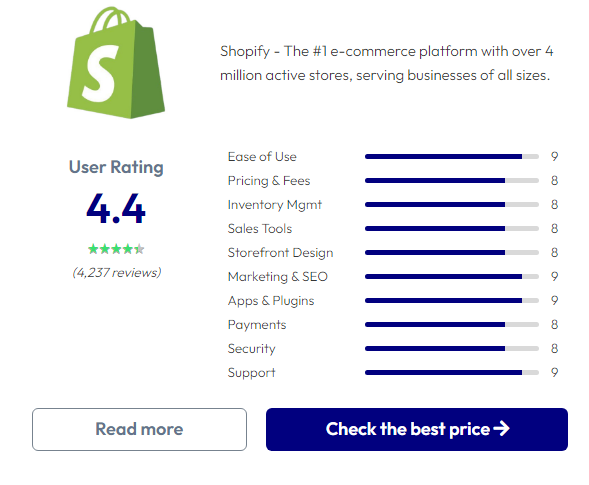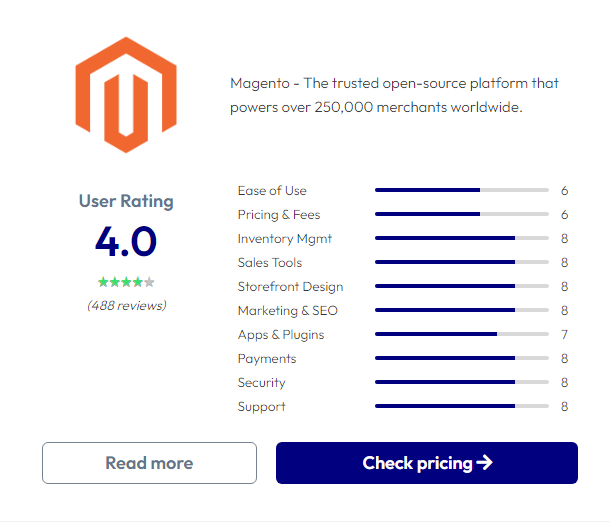Shopify vs Magento: Full Comparison Review (2023)
Both the well-known e-commerce systems Shopify vs Magento allow you to showcase your items to a sizable online audience. But they are very different tools.
Selling on Shopify is similar to renting an online space with all the tools necessary to make it into a fully operating business. Because of this, Shopify is the best option.
Magento, on the other hand, is appropriate for business owners who have web development knowledge and are searching for an e-commerce platform with enterprise-level features and more freedom in how they create their online shop.
Shopify vs Magento: Pros and Cons
| . | Shopify | Magento |
|---|---|---|
| Pros |
|
|
| Cons |
|
|
Shopify vs. Magento: In-Depth Comparison
Ease of Use
Being a fully-hosted e-commerce platform, Shopify comes with pre-built website servers, domains, and layouts. Just add items like goods, collections, or navigation menus to get started selling.
Magento, on the other hand, needs some technical know-how to set up your store or add themes or plugins. As a result, you will have greater freedom to personalize your shop.
Pricing & Fees
One of the most important considerations when choosing an eCommerce platform is price. Whereas Magento offers flexible pricing to meet your business’s demands and volume, Shopify has set subscription levels.
Shopify Pricing & Fees

Pricing Plan
There are five price tiers available on Shopify, with the following charges each month.
- Starter – $5 per month
- Basic – $39 per month
- Shopify plan – $105 per month
- Advanced plan – $399 per month
- Shopify Plus – Around $2000 per monthFees
Transaction fees & credit card fees
Shopify charges transaction fees for each online and physical purchase. Your payment gateway provider also levies credit card fees. Depending on the Shopify price plan you choose, different costs apply.
You won’t be charged any transaction fees for any plans if you utilize Shopify Payments, the platform’s integrated payment system. Nevertheless, both in-person and online transactions are subject to a credit card charge.
Magento Pricing & Fees

Pricing
Magento doesn’t offer set price structures. The platform provides a free download and shop setup option. But, there are costs associated with web hosting, domains, extensions, licenses, and more.
The Magento platform is offered in 3 versions, including:
- Magento Open Source (Free)
- Adobe Commerce
- Adobe Commerce on Managed Services
With these Magento versions, there are no set pricing. But, the amount you pay will vary based on your annual sales.
Fees
Hosting cost
Depending on your hosting company, Magento hosting costs might range from $10 to $15 per month.
Domain name
Any domain type you select will affect the yearly domain name prices.
- A brand new domain: $10-20 per year
- An expired domain: $20-40 per year.
SSL Certificate
To increase the security of your Magento website and guard against data breaches, use an SSL certificate. The typical annual cost is between $5 and $300.
Web design cost
- An e-commerce website design typically costs between $0 and $180.
A bespoke theme will set you back more than $5000.
Sales Tools
Both platforms give businesses great sales resources. There is one thing that differentiates them, though. The main sales tools each company provides are listed below.
| Built-in sales tools | Shopify | Magento |
|---|---|---|
| Up-sell and Cross-sell | Yes | Yes |
| Generating deals, coupons, and gift cards | Yes | Yes |
| Point of Sales (POS) | Yes | No |
| Abandoned cart recovery | Yes | Yes |
| Multi-channel selling | Yes | No |
| Digital products sales | Yes | Yes |
| Partnership with USPS, DHL Express, UPS, and Canada Post | Yes | No |
| Reports | Yes | Yes |
| Reductions in price and a fixed proportion | No | Yes |
| Customization at checkout | Limited | Yes |
Storefront Design
When it comes to customizing your online business, both Shopify and Magento provide a wide range of possibilities. To install and customize a Shopify theme, however, is simpler than doing so with Magento’s templates, which necessitates some technical knowledge.
Shopify Themes
Shopify provides over 100 paid and free themes, ranging in price from $150 to $350. You will always discover the ideal theme because each one is tailored specifically for a particular industry type.
Shopify Themes features
- Your Shopify themes may be altered by adding, removing, and resizing components using the drag-and-drop editor.
- All themes have been responsive and optimized for mobile.
- Both the picture and color scheme are customizable.
- Your Shopify themes can incorporate social media feeds.
Magento Themes
Comparatively speaking to Shopify, Magento has a smaller selection of themes. In the Magento marketplace, 6 themes are offered.
Magento themes features:
- Although it necessitates some coding experience, you have more flexible customization choices.
- Your homepage can include animations and a list of highlighted products.
- You can choose to include a newsletter option in the footer of your website.
- On your product pages, you may include “cross-selling blocks.”
Payments
Around 100 different payment processors are supported by Shopify. Even its own payment processor, Shopify Payments, is available. You can avoid the transaction fees imposed by Shopify if you choose this option.
In accordance with your existing Shopify pricing plans, Shopify additionally assesses a particular fee to merchants for each credit card transaction.
As Magento lacks a built-in payment gateway, you must rely on a third-party payment processor to collect payments from your clients. Because your customers pay directly through your selected payment source, Magento does not charge transaction fees either.
Conclusion
Depending on your sort of business, financial situation, and objectives, you should choose either Shopify or Magento. We hope the information we have provided above will help you wrap up the Shopify vs Magento head-to-head game and decide if Magento or Shopify is right for you. If you are still having trouble making the decision to choose Magento or Shopify, you can contact Onextdigital, which is ready to help you make the best decision.
Onextdigital is a website development and business growth company for its e-commerce venture. We also offer affordable Shopify Development, BigCommerce Development and Magento Development services along with a team of knowledgeable professionals and developers that work closely with designers.
>Read also




